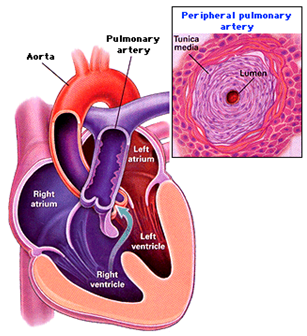Index
Eisenmenger Syndrome

What Is Eisenmenger Syndrome?
Eisenmenger's syndrome is defined as the process in which a long-standing left-to-right cardiac shunt
caused by a congenital heart defect (typically by a ventricular septal defect, atrial septal defect, or less commonly,
patent ductus arteriosus) causes pulmonary hypertension and eventual reversal of the shunt into a cyanotic right-to-left shunt.
Because of the advent of fetal screening with echocardiography early in life, the incidence of heart defects progressing
to Eisenmenger's has decreased.
What Causes Eisenmenger Syndrome?
A number of congenital heart defects can cause Eisenmenger syndrome, including atrial septal defects,
ventricular septal defects, patent ductus arteriosus, and more complex types of a cyanotic heart disease.

What are the Signs & Symptoms of Eisenmenger Syndrome?
Eisenmenger's syndrome in a pregnant mother can cause serious complications, though successful delivery has been reported.
Maternal mortality ranges from 30% to 60%, and may be attributed to fainting spells, blood clots forming and traveling to distant sites in the veins,
hypovolemia, coughing up blood or preeclampsia. Most deaths occur either during or within the first weeks after delivery.
Pregnant women with Eisenmenger syndrome should be hospitalized after the 20th week of pregnancy - or earlier if clinical deterioration occurs.
HEART CONDITIONS Diseases and Treated FAQ's
By echo study that shows right to left shunt. Catheterization for assessment of the pulmonary
artery pressure if its two thirds of systemic pressure this will preclude repair of the defects.
- If the inciting defect in the heart is identified before it causes significant pulmonary hypertension, it can
normally be repaired through surgery, preventing the disease.
- After pulmonary hypertension is sufficient to reverse the blood flow through the defect, however, the mal adaptation is considered irreversible, and a heart–lung transplant or a lung transplant with repair of the heart is the only curative option.
Transplantation is the final therapeutic option and only for patients with poor prognosis and quality of life. Timing and appropriateness of transplantation remain difficult decisions.
- 5-year and 10-year survival ranges between 70% and 80%, 50% and 70%, 30% and 50%, respectively.
Since the average life expectancy of patients after lung transplantation is as low as 30% at 5 years, patients with reasonable functional status related to Eisenmenger syndrome have improved survival with conservative medical care compared with transplantation.
- Various medicines and therapies for pulmonary hypertension are under investigation for treatment of the symptoms.
- Air filters for intravenous lines are recommended for persons with Eisenmenger's syndrome who have been hospitalized to reduce the risk of accidental introduction of air into the veins due to the increased risk for paradoxical air embolism.
If air is introduced into the veins and travels through the ventricular septal defect into the arterial circulation, a stroke may occur.
- After pulmonary hypertension is sufficient to reverse the blood flow through the defect, however, the mal adaptation is considered irreversible, and a heart–lung transplant or a lung transplant with repair of the heart is the only curative option.
Transplantation is the final therapeutic option and only for patients with poor prognosis and quality of life. Timing and appropriateness of transplantation remain difficult decisions.
- 5-year and 10-year survival ranges between 70% and 80%, 50% and 70%, 30% and 50%, respectively.
Since the average life expectancy of patients after lung transplantation is as low as 30% at 5 years, patients with reasonable functional status related to Eisenmenger syndrome have improved survival with conservative medical care compared with transplantation.
- Various medicines and therapies for pulmonary hypertension are under investigation for treatment of the symptoms.
- Air filters for intravenous lines are recommended for persons with Eisenmenger's syndrome who have been hospitalized to reduce the risk of accidental introduction of air into the veins due to the increased risk for paradoxical air embolism.
If air is introduced into the veins and travels through the ventricular septal defect into the arterial circulation, a stroke may occur.